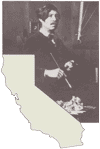![]()

Five Views: An Ethnic Historic Site Survey for California
MENU
Introduction
Mexican War
Post-Conquest
1900-1940
World War II
Chicano Movement
Future
Historic Sites
Selected References

A History of Mexican Americans in California:
HISTORIC SITES
Asociacion de Charros Camperos Del Valle
Sunol, Alameda County
Organized in 1971, the Asociacion de Charros Camperos del Valle in Sunol is located on a 25-acre site in Alameda County. The stables, horse stalls, lienzo (arena), a small trailer, and horse training equipment are on about two acres in the middle of the property. The remaining area of open land is used for parking and for training and exercising horses.
The California Charro Association promotes and maintains the tradition of the charriada in Mexicano/Chicano communities throughout California. The organization is composed of charro associations from San Jose, Vallejo, Stockton, Sunol, Los Angeles, Sacramento, and Dixon. The Asociacion de Charros Camperos del Valle in Sunol is one of the larger and more active groups in the state. It is included in this survey as representative of the charro tradition in California.
The varied tradition of charros and charriadas is deeply rooted in the history and culture of California, Mexico, and Latin America. In these regions, where ranching developed as the primary economy and where horses and skilled horsemanship were essential for survival, people developed a tradition that celebrates life and death as well as the unity of man and beast. A skilled horseman is a charro. A charriada is a competition of skilled horsemen, in which members of different associations meet to re-enact and celebrate humanity's never-ending struggle with life, and thus, with death. Each feat or part of the competition has particular significance, and requires particular skills, dexterity, balance, courage, and knowledge. The tradition involves a ritual that re-affirms and celebrates our common human struggle. It is, in essence, an art form.
The charro tradition is most highly developed in Mexico. It is the Mexican variant that charro associations practice in California. Each group has its own lienzo (arena) where performances are held during the season, which runs from early May to mid-October. During the season, competitions are held with nearby charro groups. The statewide Congreso, where all groups compete and the winner becomes State Champion, is usually held in Los Angeles.
In California and most of the Southwest, charro organizations have existed throughout the twentieth century. Their existence, however, has largely been contingent on the economic conditions of the Mexicano/Chicano community, because money and land are required for mounts, a lienzo, stables, and other facilities. Thus, although charro groups have existed since the early twentieth century, they have become most economically viable since the early post-World War II period. The statewide competition dates from this latter period.
The earlier tradition of skilled horsemanship that evolved in California and the Southwest before American occupation, and that subsequently evolved into the North American rodeo, was less formal than the Mexican tradition. While it contained the same essential characteristics as the charriada, it had not developed into an art form by the time of the American conquest. This earlier form, the rodeo, which is now an integral part of American western culture, also originated with the ranching economy and culture of California and the Southwest. Development of cattle ranching and the cattle industry in the American West rests squarely on the foundations laid during the Spanish/Mexican period. Thus, the origins of both the charro and the American rodeo tradition are in the Hispanic world.
Charriadas are well-attended throughout California. They begin in the early afternoon with presentation of the association or associations, move on to the performance or competition, and end with a dance for the entire community in the evening. Each part of the program is accompanied by music. Food, of course, is very much part of the day. Members of the Mexicano/Chicano community attend charriadas in large numbers. The lienzo at Sunol, which has a seating capacity of several hundred, is usually full during the season.

Asociacion de Charros Camperos del Valle, Sunol, Alameda County
NEXT> Casa Blanca School
Last Modified: Wed, Nov 17 2004 10:00:00 pm PDT
5views/5views5h6.htm
 Top
Top